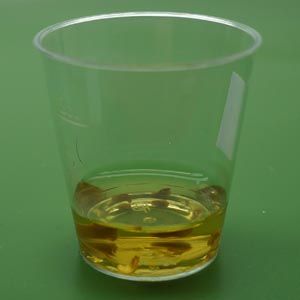CHILI GUIDE
sowing
Soak-in-camomile tea Soak in camomile tea
Chili seeds can be sown all year round. However, we recommend sowing from the middle of December to the end of March. Because of the wintry light conditions, this works in December and January only with artificial light. February and March succeeds the breeding even without artificial light.

Early sowing ensures the necessary time for the plant development and the ripening of the berries into the autumn. Although there are varieties that grow fast and mature nevertheless most varieties need 100 and more days from the flowering to the harvest.
Helpful for successful germination is the pre-swelling of the chili seeds. The seed is e.g. In chamomile tea. The chamomile disinfects the seeds, making them less susceptible to unwanted germs and bacteria. After 24 hours in the tea, the sowing should be done.
The seeding of the chili seeds can basically take place in any vessel. Whether in the finished miniature greenhouse, in the flower pot or in the yoghurt cup - everyone to their taste. The choice of the earth is not insignificant for a successful breeding. A mixture of flowering and cultivating end is usually used. This mixture provides enough nutrients and prevents the "burning" of the delicate roots. Cultivation pots (from peat or coconut) are also very popular.
germination
Chili seeds are not light nuclei, so they must be easily covered (0.5-1 cm) with soil. There is not an optimal distance between seeds, 2-5 cm should be nevertheless. The correct mixture of moisture and heat is important for germination. At 24 - 30 ° C - ensured by a heater or a heating mat - chili seed feels particularly comfortable and with good humidity the germination is only a factor of time. In order to prevent possible mold formation, it is necessary to ventilate regularly. In particular, mined greenhouses and seedbeds covered with fresh-keeping foil are susceptible to mold formation.
Pique and move
At ideal conditions, the seeds do not last long under the soil. For most varieties it takes 1-3 weeks for the first green peaks to look out of the earth. If after 6 weeks still nothing germinates, the attempt can be considered as unsuccessful. In particular, the genus Capsicum chinense takes a long time for germination.
At the latest when the first shoots are present, a lot of light or solar radiation is necessary. Without enough light, the plantlets "squirt" and there is the danger that no strong growth is possible.
If no cultivation is possible on a sunny south window, help with special plant lamps or with fluorescent tubes. The light source should hang 15 - 20cm above the plants and give 12 - 18 hours of light every day. With a timer, the artificial light can also be controlled automatically.
After the second to third leaf pair (without the pair of kebabs) the small plants need more space. When the plants are separated, the roots must not be damaged. Since the repotting for the chilli plants means stress, in principle can already be planted in the final summer pot. In the absence of sufficient space, however, this can be implemented rather seldom. Usually it is transplanted into smaller flower pots. In doing so, the plants are placed under the lowest pair of leaves in the nursery and carefully pressed. This creates more roots and the plants grow more vigorously. The plants always use a little deeper than they were before. Underdeveloped plants should be screened out, since more than one seed is used, the loss is also possible.
After planting, the plants must rest in a bright and warm place
Repotting or transplanting
In order to ensure a balanced growth for the chili plants, it is advisable to re-plant in time. It is recommended to choose the new pot so that it has 6-8 cm more diameter than the old pot. For most chilies it is sufficient to re-seed twice, once from the cultivation / germination substrate into a 8 - 10 cm pot and once into a 20 - 30 cm pot.
The plants should be well provided with nutrients for the next 4 weeks in order to be able to grow into the new substrate and grow diligently. Who buys its soil in the store has thus a pre-fertilized substrate and needs in this time probably not fertilize. Too much fertilizer can be more problematic than a temporary nutrient deficiency.
Place a new place in the new pot to create a recess in the new substrate. Carefully remove the plant from the pot. It is recommended to take the trunk between the middle and the pointed finger. This ensures that you do not need to be manipulated unnecessarily on the root ball, the leaves while the old pot is being removed. Without having to plant the plant, it can now be inserted into the created placeholder. Press the surrounding soil slightly and if necessary fill up with soil.
blossom
Flowering chili plants are pollinated by wind and insects alone. Anyone who breeds in closed rooms must manually pollinate to obtain berries. This can be easily painted with a cotton swab or brush over the flowers. When breeding in the open it must be expected that different varieties mix. If you cultivate different chilli varieties, the originally sown varieties will get, but from it will be produced seed possibly hybrids.
harvest
Chilis are ripe and full of flavor when they are completely dyed. Of course, green chiles are also edible and already sharp. Ripe chilies can occur in all possible colors: red, yellow, black, white, etc. Depending on the variety, the coloring can last up to 2 months.
As diverse as the colors are so diverse, the shapes and sizes of the chilis. From tiny round shapes, to apple-shaped, pointed shapes or wrinkled surfaces, everything is possible depending on the variety.